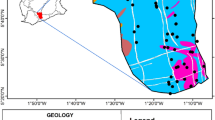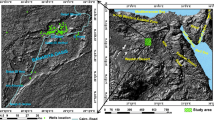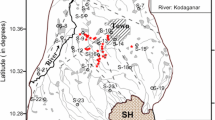Abstract
The South Texas Sand Sheet (STSS) consists predominantly of medium- to fine-grain eolian sand deposits and sand dunes. STSS covers over six counties with an area of approximately 9.15 × 103 km2 with thickness ranging between less than a meter and over 10 m. Groundwater contamination is of particular concern as groundwater resources are the principal water source in this area. The preliminary conceptual hydro-geologic model implies that the STSS is a significant hydrologic component for shallow groundwater flow and can be potential storage and/or significant environmental flow input into nearby hypersaline Lower Laguna Madre (LLM). Water (fresh/brackish) held in the STSS should be taken into consideration when accounting for regional water balance/budget, e.g., groundwater recharge and storage, flood control, and discharge to coastal areas. The geospatial analysis was conducted using geographic information systems (GIS) spatial analysis tools with well logs from Texas Water Development Board (TWDB) groundwater database and preliminary drilling in the field. A DRASTIC model developed within a GIS framework was applied to evaluate the groundwater vulnerability of the STSS. DRASTIC modeling suggested that STSS with high risk to pollution is mainly located in the eastern portions of the STSS where factors, i.e., high hydraulic conductivity and high-water table, allow easy access for contaminants to reach the shallow groundwater aquifer. The assessment found that around 94% of the unconfined aquifer in STSS has moderate to high vulnerability to contamination. The sensitivity analysis of DRASTIC model showed that the removal of hydraulic conductivity, topography, and soil media parameters caused an increase in groundwater vulnerability to pollution. Moreover, single-parameter sensitivity analysis results suggested that the net recharge rate, hydraulic conductivity, and soil media parameters were more effective in determining the groundwater vulnerability than the DRASTIC model assumed. Results of this study suggest that the groundwater vulnerability in STSS is high and assessment maps can be used to evaluate possible environmental and economic impacts to ecosystems on the adjacent Lower Laguna Madre.



(Adapted from TWDB 2017)

(Adapted from Khosravi et al. 2018; https://www.sfu.ca/personal/dallen/drastic_page.html)








Similar content being viewed by others
Data availability
The data that support the findings of this study are available from the corresponding author upon reasonable request.
Code availability
DRASTIC is available under U.S. EPA (EPA600285018). 600285018 Drastic A Standardized System For The Evaluating Groundwater Pollution Using Hydrogeologic Settings.
References
Albinet M, Margat J (1970) Groundwater pollution vulnerability mapping. In: Bulletin du Bureau de Recherches Géologiques et Minières Bull BRGM 2nd series, vol 3, issue 4, pp 13–22
Aller L, Lehr JH, Petty R (1987) DRASTIC: a standardized system to evaluate ground water pollution potential using hydrogeologic settings. In: National water well Association Worthington, Ohio 43085. Truman Bennett. Bennett and Williams. Inc. Columbus, Ohio, 43229
Babiker IS, Mohamed MA, Hiyama T, Kato K (2005) A GIS-based DRASTIC model for assessing aquifer vulnerability in Kakamigahara Heights, Gifu Prefecture, central Japan. Sci Total Environ 345(1–3):127–140
Brown LF, Brewton JL, Evans TJ, McGowen JH, White WA, Groat CG, Fisher WL (1980) Environmental geologic atlas of the Texas Coastal Zone: Brownsville-Harlingen area. University of Texas at Austin. Bureau of Economic Geology, p 9
Cheng C-L, Gonzalez J (2016) Significance of South Texas Sand Sheet in water resource management for Lower Rio Grande Valley. Geological Society of America Abstracts with Programs. vol 48, issue 1
Civita M (1994) Le carte della vulnerabilita degli acquiferi all’inquinamiento: teoria e pratica [Contamination vulnerability mapping of the aquifer: theory and practice]. Quaderni di Tecniche di Protezione Ambientale, Pitagora Editrice
Denny S, Allen DM, Journeay M (2007) DRASTIC-Fm: a modified vulnerability mapping method for structurally-controlled aquifers. Hydrogeol J 15:483–493. https://doi.org/10.1007/s10040-006-0102-8
Doerfliger N, Zwahlen F (1997) EPIK: a new method for outlining of protection areas in karstic environment. In: International symposium and field seminar on “karst waters and environmental impacts”, edited by: Günay, G. and Jonshon, AI, Antalya, Turkey, Balkema, Rotterdam, pp 117–123
Driscoll FG (1986) Groundwater and wells, 2nd edn. Johnson Division, St. Paul, Minnesota, p 1089
Evans BM, Myers WL (1990) A GIS-based approach to evaluating regional groundwater pollution potential with DRASTIC. J Soil Water Conserv 45(2):242–245
Forman S, Nordt L, Gomez J, Pierson J (2009) Late Holocene dune migration on the South Texas sand sheet. Geomorphology 108(3–4):159–170
Foster SSD (1987) Fundamental concepts in aquifer vulnerability, pollution risk and protection strategy: international conference, 1987, Noordwijk Aan Zee, the Netherlands vulnerability of soil and groundwater to pollutants. Netherlands organization for applied scientific research, The Hague, pp. 69–86
Foster SSD (1998) Groundwater recharge and pollution vulnerability of British aquifers: a critical overview. Geol Soc Lond Spec Publ 130(1):7–22
Fritch TG, McKnight CL, Yelderman JC Jr, Arnold JG (2000) An aquifer vulnerability assessment of the Paluxy aquifer, central Texas, USA, using GIS and a modified DRASTIC approach. Environ Manag 25(3):337–345
Ghosh A, Tiwari AK, Das S (2015) A GIS based DRASTIC model for assessing groundwater vulnerability of Katri Watershed, Dhanbad, India. Model Earth Syst Environ 1(3):11
Goldscheider NICO, Klute M, Sturm S, Hötzl H (2000) The PI method–a GIS-based approach to mapping groundwater vulnerability with special consideration of karst aquifers. Z Angew Geol 46(3):157–166
Gonzalez E, Cheng C-L, Gonzalez J, Hardage SMF (2017) Subsurface 3D model of South Texas Sand Sheet and regional hydrologic systems. In: 2017 GCAGS (Gulf Coast Association of Geological Societies), 67th Annual Convention, San Antonio, Texas (November 1–3, 2017)
Gonzalez E, Soto-Sanchez L, Cheng C-L (2019) Building community-based water resource sustainability and resilience: a case study of shallow groundwater availability and vulnerability in South Texas. In: The Geological Society of America Annual Meeting, Geological Society of America (GSA), Phoenix, Arizona (September 2019)
Khosravi K, Sartaj M, Tsai FTC, Singh VP, Kazakis N, Melesse AM, Prakash I, Bui DT, Pham BT (2018) A comparison study of DRASTIC methods with various objective methods for groundwater vulnerability assessment. Sci Total Environ 642:1032–1049
Liggett JE, Allen DM (2011) Evaluating DRASTIC using different data sources, interpretations and mapping approaches in areas of limited geological variability. Environ Geol 62:1577–1595. https://doi.org/10.1007/s12665-010-0642-z
Lodwick WA, Monson W, Svoboda L (1990) Attribute error and sensitivity analysis of map operations in geographical informations systems: suitability analysis. Int J Geogr Inf Syst 4(4):413–428
Margat J (1968) Contamination vulnerability mapping of groundwater. Bureau de Recherches Geologiques et Minieres, Orleans
Napolitano P, Fabbri AG (1996) Single-parameter sensitivity analysis for aquifer vulnerability assessment using DRASTIC and SINTACS. IAHS Publ Ser Proc Rep Intern Assoc Hydrol Sci 235:559–566
Pathak DR, Hiratsuka A, Awata I, Chen L (2009) Groundwater vulnerability assessment in shallow aquifer of Kathmandu Valley using GIS-based DRASTIC model. Environ Geol 57(7):1569–1578
Rahman A (2008) A GIS based DRASTIC model for assessing groundwater vulnerability in shallow aquifer in Aligarh, India. Appl Geogr 28(1):32–53
Russel JL (1981) The South Texas eolian sand sheet. In: Russel JL, Sterling CE (eds) Modern depositional environments of sand in south Texas. Gulf Coast Association of Geological Societies, Corpus Cristi, Texas, pp 43–46
Saavedra M, Gonzalez JL (2019) Mineralogical and textural characterization of eolian sands on the South Texas Sand Sheet. In: Geologic Society of America Joint 53rd South-Central Section Meeting, Geological Society of America, Manhattan Kansas. Geological Society of America. Vol 51, issue 2, ISSN 0016-7592. https://doi.org/10.1130/abs/2019SC-327483
Shirazi SM, Imran HM, Akib S (2012) GIS-based DRASTIC method for groundwater vulnerability assessment: a review. J Risk Res 15(8):991–1011
Singh PK, Tiwari AK, Panigarhy BP, Mahato MK (2013) Water quality indices used for water resources vulnerability assessment using GIS technique: a review. Int J Earth Sci Eng 6(6–1):1594–1600
Stempvoort DV, Ewert L, Wassenaar L (1993) Aquifer vulnerability index: a GIS-compatible method for groundwater vulnerability mapping. Can Water Resour J 18(1):25–37
Texas Natural Resources Information System (TNRIS) (2020) https://data.tnris.org/. Accessed 18 Jan 2021
Texas Water Development Board (TWDB) (2020) Water data interactive, groundwater viewer. https://www3.twdb.texas.gov/apps/WaterDataInteractive/GroundwaterDataViewer/?map=gwdb. Accessed 9 Sept 2020
Uddameri V, Honnungar V (2007) Combining rough sets and GIS techniques to assess aquifer vulnerability characteristics in the semi-arid South Texas. Environ Geol 51(6):931–939
United States Department of Agriculture (USDA) (2020) Web soil survey. https://websoilsurvey.sc.egov.usda.gov/App/WebSoilSurvey.aspx. Accessed 18 Jan 2021
United States Environmental Protection Agency (1990) Office of Ground-Water Protection. Citizen’s guide to ground-water protection. Office of Ground-Water Protection, Office of Water, US Environmental Protection Agency
United States Geological Survey (Texas Water Science Center USGS TWSC) (2020) Geologic database of Texas. https://data.tnris.org/. Accessed 18 Jan 2021
Acknowledgements
Authors thank the Presidential Graduate Research Assistantships (PGRA) awarded to Syed Ahmed by the Graduate College of University of Texas- Rio Grande Valley. Authors also acknowledge partial assistantship support provided by the Department of Civil Engineering and School of Earth Environmental and Marine Sciences. Dwight Capus conducted lab infiltration experiments and data analysis. Eli Gonzalez initiated data collection, analysis and draft manuscript at early stage. SHIP-GEO “Stimulating Hispanic Participation in the Geosciences” (NSF-ICER-1600585) also partially supported undergraduate students (Marcelo Saavedra and Adam Flores) and lab materials for limited field work that contributed to this manuscript.
Funding
Ahmed was supported by the Graduate College of University of Texas- Rio Grande Valley and partial support was provided by the Department of Civil Engineering and School of Earth Environmental and Marine Sciences. Soto-Sanchez was supported partially with teaching and research assistantship provided by School of Earth Environmental and Marine Sciences and College of Science of University of Texas- Rio Grande Valley.
Author information
Authors and Affiliations
Contributions
SIA conducted data collection, data analysis, and manuscript assembly; CLC contributed with experimental design, data analysis, manuscript assembly and preparation; JG contributed with technical data and manuscript review; JJK contributed with technical data and manuscript review; JH contributed with technical data and manuscript review; LS-S conducted data collection and data analysis.
Corresponding author
Ethics declarations
Conflict of interest
The authors declare no conflict of interest.
Additional information
Publisher's Note
Springer Nature remains neutral with regard to jurisdictional claims in published maps and institutional affiliations.
Rights and permissions
About this article
Cite this article
Ahmed, S.I., Cheng, CL., Gonzalez, J. et al. Groundwater vulnerability assessment of shallow aquifer in the South Texas sand sheet using a GIS-based DRASTIC model. Model. Earth Syst. Environ. 8, 4075–4091 (2022). https://doi.org/10.1007/s40808-021-01292-4
Received:
Accepted:
Published:
Issue Date:
DOI: https://doi.org/10.1007/s40808-021-01292-4




